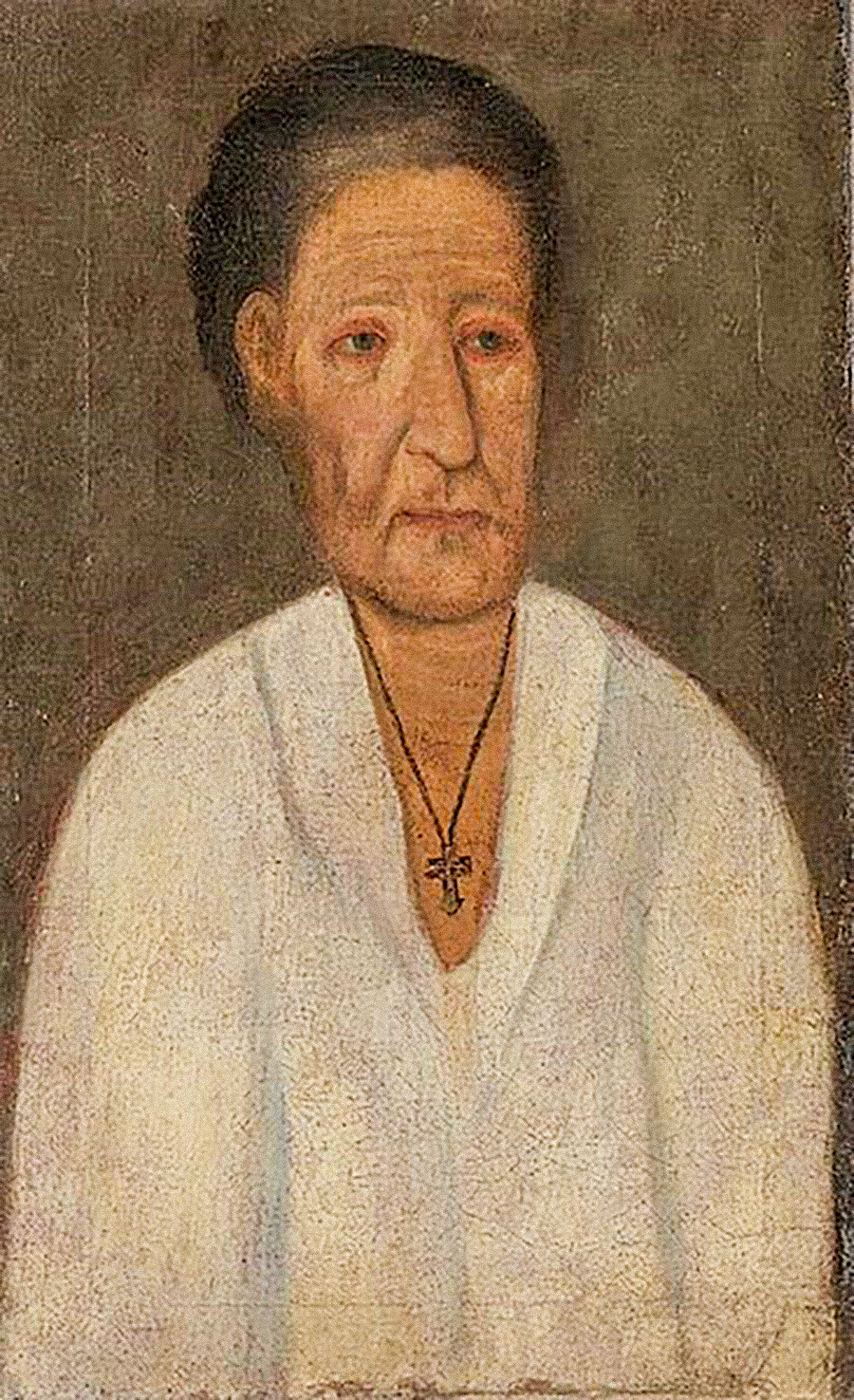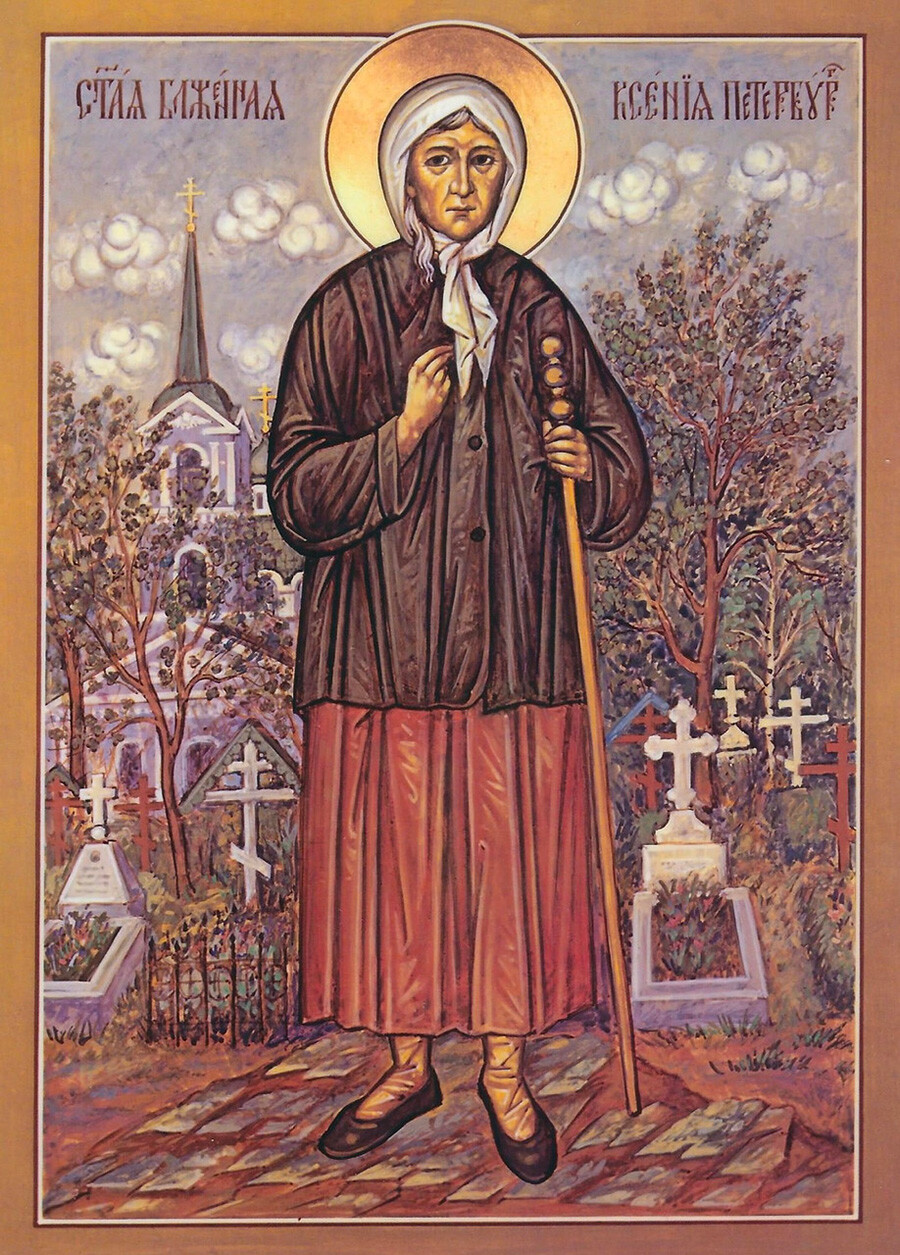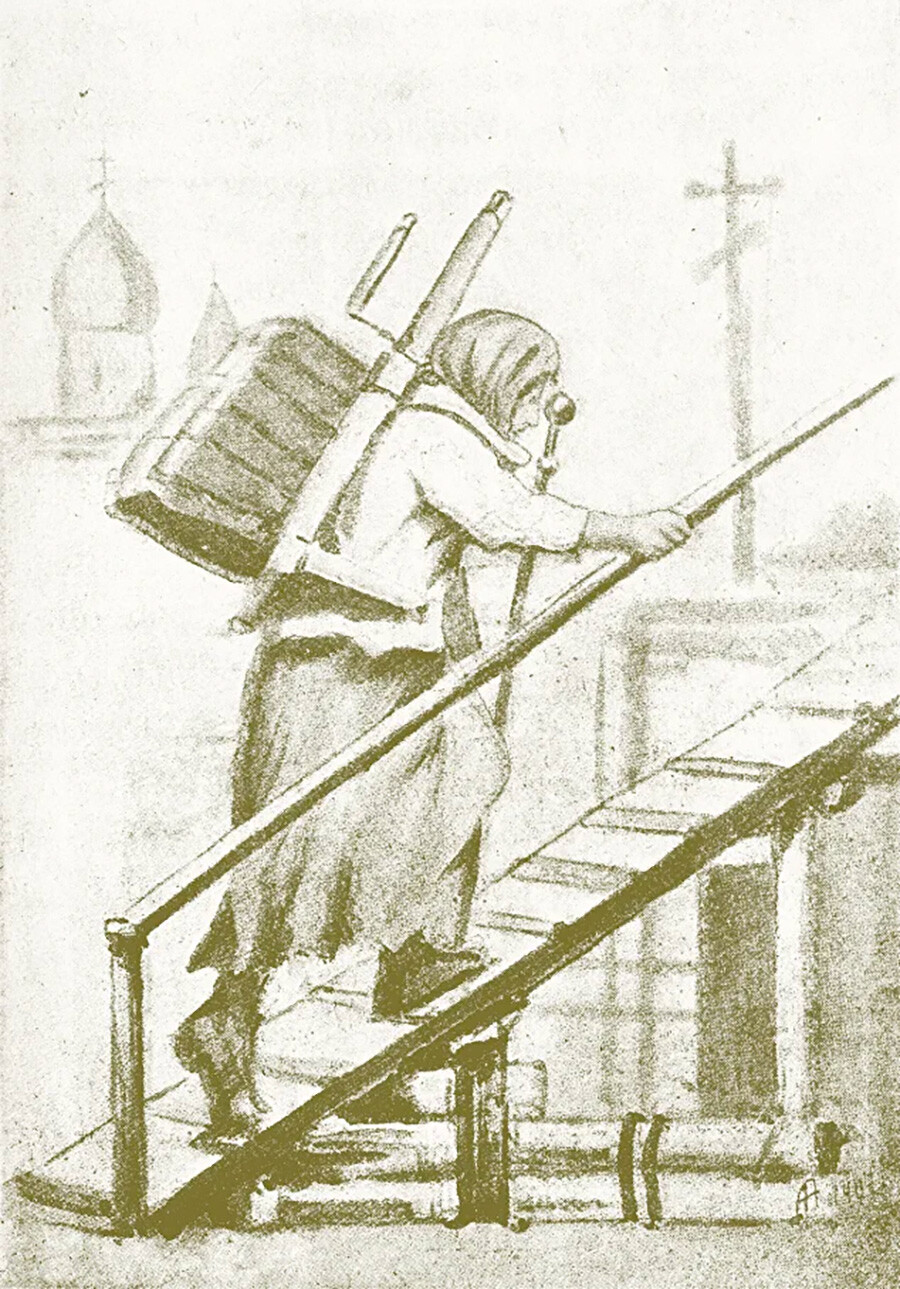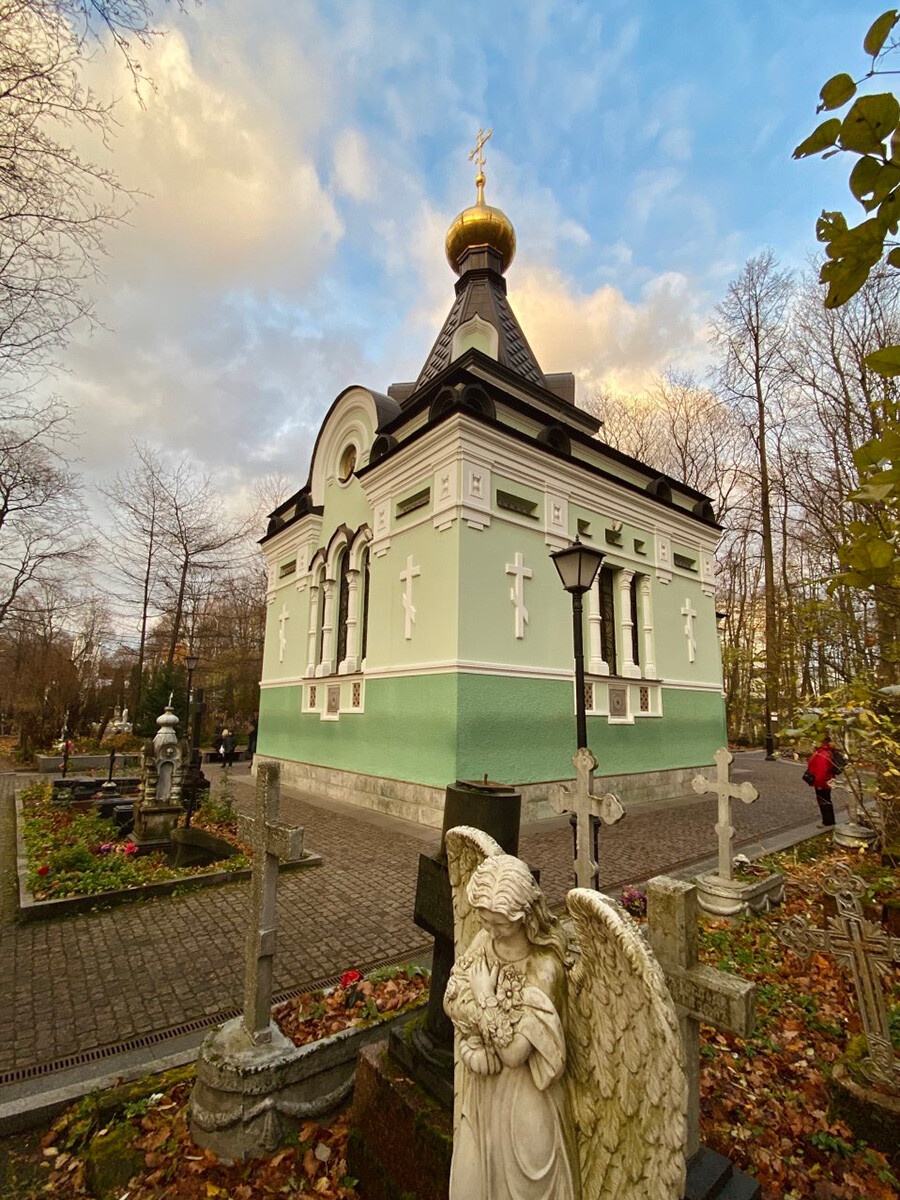
In 1757, Colonel Andrei Fyodorovich Petrov of the Preobrazhensky Life Guards Regiment passed away. His spouse, Xenia, started wearing his uniform - a green kaftan and red trousers, and then suddenly announced to everyone that "Xenia Grigoryevna has died". She told people to call her Andrei Fyodorovich.
Her husband had died unexpectedly, with no time to receive the sacraments. In order to seek the salvation of her husband's soul, Xenia took it upon herself to follow the path of a "holy fool", which is how her contemporaries remembered her. This is also how she is depicted in modern icons - in her red and green "Transfiguration" attire (the name of the regiment, Preobrazhensky, comes from the word "Preobrazheniye" - "Transfiguration").

A reconstruction of the alleged Xenia's appearance - from the Museum of St. Xenia of St. Petersburg
Mrkhlopov (CC BY-SA)Upon receiving her inheritance, the 26-year-old widow, who was from a noble family, renounced her worldly possessions and distributed them among the poor. She signed a deed gifting her house to Paraskeva Antonova, a widow who had rented a room in her house, and donated the money to the Church "for the repose of the soul of Xenia".
The relatives of her late husband decided that Xenia had lost her mind and petitioned Andrei Fyodorovich's superiors for guardianship over their relative to stop her giving away her property and possessions due to her mental impairment. On summoning the widow for an interview, the state officials concluded that she was of sound mind and legally capable, and was entitled to dispose of her property and possessions as she saw fit.
It is worth noting that the attitude to "holy fools" was strict at the time. Peter the Great had created a legislative basis for eradicating false "holy-foolishness" and related displays of what was regarded as hysterical frenzy. His goal was to eliminate the temptation by charlatans to claim such a ‘holy’ status.
Apart from "holy fools" who were genuinely mad or adopted "voluntary madness" or asceticism, there were more than enough fake "fools" in Old Russia who merely wanted to ignore social conventions, laws and decencies. They often were provocateurs seeking to incite social or political unrest under the guise of feeble-mindedness; and there were also beggars in pursuit of personal enrichment. By decree of Peter the Great, from the beginning of the 18th century "holy foolishness" was punishable by torture and jail. Regarding the actions of Xenia, however, with her noble background and charitable deeds, no corpus delicti was ever found.
Xenia didn't beg for money from the townspeople, and she often refused alms when it was offered. When she did take some kopeks, she gave it to the poor straight away. She was meek, modest and did not display the aimless behavior characteristic of the mentally ill. In the daytime she roamed the streets, sometimes calling on acquaintances, and at night, as was observed by the police who followed her, she went to the fields outside the city and spent hours in prayer. Occasionally she was put up for the night at one of her few acquaintances.

An alleged Xenia's portrait
Public domainOver time, St. Petersburgers noticed that life tended to improve for those on whom she bestowed her attention. Merchants at the market would ask her to stop by their shops in hopes that her presence might improve business. Mothers with children would hurry towards Xenia and ask her to bless their child, or simply stroke his/her head, believing that this would heal the child and bring it good fortune.
Just before Christmas 1761, Xenia ran through the streets anxiously shouting, "Make pancakes, make pancakes, soon all of Russia will be making pancakes!" The townspeople sensed that something was amiss since in the Orthodox tradition pancakes are an obligatory dish at funeral wakes. Sure enough, on December 25, Empress Elizaveta Petrovna died.

Saint Blessed Xenia of St. Petersburg icon
Public domainIn 1764, she foretold the death of the heir to the throne, Ivan VI (Ioann Antonovich), who was arrested at the age of two with his entire family. From the age of 16, Ivan was held in solitary confinement in the Shlisselburg Fortress (six years later he was killed there).
On the eve of the young man's death, Xenia couldn't stop crying, and when asked what was wrong she replied: "Blood, blood, blood… The rivers are running with blood, the canals are full of blood, there is blood, blood…" A few weeks later Ivan was stabbed to death when his supporters attempted to release him from captivity.
Sometimes Xenia would give unexpected, cryptic advice that ended up changing the lives of her interlocutors. Turning up on the doorstep of her old house, she told the new owner, Paraskeva Antonova, that "God has sent her a son" and she must go to the Smolenskoye Cemetery without delay. The woman hurried to where she had been ordered to go. Near the cemetery she saw a crowd and learnt that a cab driver had knocked down a woman in an advanced stage of pregnancy, who then gave birth on the spot and died soon afterwards. Paraskeva took the child and, having realized that his relatives would not come for him, named him Andrei and adopted him.

I. Ganzenko. Evidence of the Miracles of Saint Blessed Xenia of Petersburg. 2021
Museum of St. Xenia of St. PetersburgOn another occasion, Xenia announced to an unmarried woman that "her husband is burying his wife in Okhta" (a district of St. Petersburg). The woman went there and found a funeral taking place. She made the acquaintance of an inconsolable widower, whose wife had died in childbirth. Within a year the woman married him and she lived with him in peace and harmony until old age.
Another man asked Xenia to pray for him, and she gave him a coin and said: "Hold on to the horse! You'll go far on it!" (The reverse side of one- and two-kopek coins featured St. George on a horse.) He became rich soon afterwards.
Construction of a brick church began at the Smolenskoye Cemetery in 1786. The workers soon noticed that bricks were appearing at the building site overnight. It turned out that after dusk and before dawn the aged Xenia was bringing the bricks and leaving them on top of the walls as they were being built.

St. Xenia lifts bricks on the bell tower of the Church of Our Lady of Smolensk. From E. Rachmanin's book "Blessed Ksenia the Servant of God".
Museum of St. Xenia of St. Petersburg"When do you sleep, Andrei Fyodorovich?" asked the builders. "We'll have plenty of time to sleep in the grave," was her reply.
Xenia was anxious that the brick masonry should be particularly strong: "It will have much to bear, but it will stand firm… It will do…" In 1824, the cemetery was devastated by a flood. A large number of crosses and graves were washed away, and the cemetery records were destroyed, but the church stood firm. Xenia, who died aged 71, was buried near this very church in the Smolenskoye Cemetery.
Xenia's grave soon became a place of pilgrimage. People who came to ask for her intercession would take away a handful of soil, and for this reason the mound on top of the grave had to be replaced twice.
There is a story that in the early 1870s Empress Maria Feodorovna beseeched Xenia to help her husband, the future Emperor Alexander III, recover from typhus. According to legend, a valet gave her sand from Xenia's grave, and the Grand Duchess placed it under the sick man's pillow. That night, she had a vision of the old woman, who foretold the recovery of Alexander and the arrival of a daughter to be named Xenia. The couple obeyed and carried out her wish.

The Chapel of St. Blessed Xenia of Petersburg was built in 1902.
Parish of the Church of the Smolensk Icon of the Mother of GodIn 1902, a chapel was built on Xenia’s grave with a marble iconostasis and a gravestone. On September 24, 1978, Xenia of St. Petersburg was canonized by the Russian Orthodox Church Outside Russia, and on June 6, 1988, she was declared a saint by the Local Council of the Russian Orthodox Church.
Dear readers,
Our website and social media accounts are under threat of being restricted or banned, due to the current circumstances. So, to keep up with our latest content, simply do the following:
If using any of Russia Beyond's content, partly or in full, always provide an active hyperlink to the original material.
Subscribe
to our newsletter!
Get the week's best stories straight to your inbox